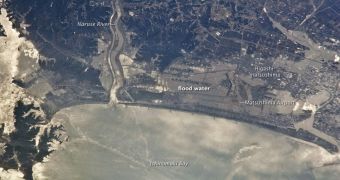Perched some 354 kilometers (220 miles) above the planet's surface, the International Space Station (ISS) provides an amazing vantage point for high-resolution photography. Unfortunately, astronauts aboard recently had the task of imaging the extent of the damage caused by the March 11 earthquake.
The tremor struck 250 kilometers away from the capital Tokyo, and did not cause massive damage on its own. Buildings in the Asian nation respect rigorous codes, and are constructed to withstand such natural disasters.
However, the country was not equally well prepared for the massive tsunami that struck its shorelines half an hour after the tremor. The giant wave caused massive damages to coastal towns, and killed hundreds, while thousands more have been declared missing.
Astronauts aboard the ISS imaged the disaster zone on March 14, and downloaded the photographs back to Earth for analysis. The hope is that they will be of use to international emergency responders as they try to handle the crisis currently taking root in Japan.
“Our thoughts are with our friends in Japan,” tweeted Italian astronaut Paolo Nespoli on March 13. He is representing the European Space Agency in Expeditions 26-27 on the orbital facility, Space reports.
In this view – which shows massive floods – one can easily distinguish parts of the Naruse river, the Ishinomaki Bay, and the city of Higashimatsushima. The extent of the tsunami-triggered floods is apparent in all portions of the view.
“Both agricultural fields and settled areas are submerged by muddy water in this image. Water left by the tsunami surrounds the crisscrossing runways at Matsushima Airport,” a NASA press release says.
Oil slicks are apparent throughout Ishinomaki Bay. They are caused by refineries that have been damaged by both the magnitude 9.0 earthquake and the ensuing tsunami, and are leaking oil products into the waters.
These are just some of the crisis the country needs to deal with. More important right now is for authorities to keep the Fukushima nuclear power plant in check. Three reactors there are in critical condition, and could experience a complete meltdown at any moment.
The tremor also affected the Tsukuba Space Center, that coordinates all Japanese space activities, such as the operations of the Kibo science module on the ISS, and also of the H-II Transfer Vehicle (HTV), which is currently docked at the station.

 14 DAY TRIAL //
14 DAY TRIAL //